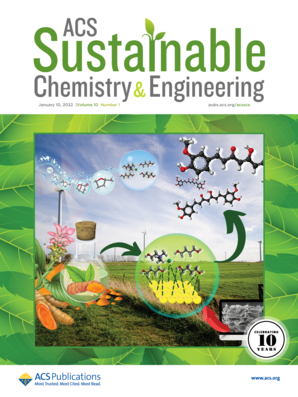Carbonic Anhydrase as a Sustainable Sealing Agent for Concrete Exposed to Chloride Attack
IF 7.3
1区 化学
Q1 CHEMISTRY, MULTIDISCIPLINARY
引用次数: 0
Abstract
Concrete, the most used engineering material in the world, is responsible for 8% of the entire CO2 emission; 80% of the failures in reinforced concrete structures are related to the corrosion of embedded reinforcement. Concrete resistivity against chloride penetration is a pivotal parameter in determining the durability of reinforced concrete structures. Self-sealing concrete has recently emerged as a powerful method for enhancing this resistance. This paper investigates the effect of carbonic anhydrase (CA) as a sealing agent on the chloride penetration of concrete by the rapid chloride penetration test (RCPT). Concrete disk specimens without CA and with two different dosages of CA were cast and cured for 14 and 28 days. Chloride penetration depths and migration coefficients were evaluated for uncracked specimens at 14 and 28 days. The lower dosage of CA was used to prepare cracked and sealed specimens. The chloride content was quantified, and service life was predicted for specimens at 28 days. In uncracked concrete, a lower dosage of CA can considerably increase concrete resistivity to chloride penetration up to 46% compared to the control specimens. Although the presence of a crack increased chloride penetration through the crack, sealing the crack showed penetration depth at the crack zone similar to the uncracked concrete. Hence, using CA enzyme as a sealing agent extends the service life of uncracked concrete and recovers the cracked concrete’s service life after sealing. Thus, the addition of enzymes will have significant implications for infrastructure sustainability and reduction of CO2 emissions related to the second industrial emitter.

碳酸酐酶在混凝土氯离子侵蚀中的可持续止水性能
混凝土是世界上使用最多的工程材料,其二氧化碳排放量占总排放量的8%;钢筋混凝土结构80%的破坏与预埋钢筋的腐蚀有关。混凝土抗氯离子渗透电阻率是决定钢筋混凝土结构耐久性的关键参数。自密封混凝土最近成为增强这种阻力的有力方法。通过快速氯离子渗透试验(RCPT)研究了碳酸酐酶(CA)作为止水剂对混凝土氯离子渗透性能的影响。不添加CA和添加两种不同掺量CA的混凝土盘试件浇筑,固化时间分别为14天和28天。在14天和28天对未开裂试样进行氯离子渗透深度和迁移系数的评估。采用低剂量的CA制备有裂纹和密封的试样。对氯含量进行了量化,并预测了28天的使用寿命。在未开裂的混凝土中,与对照试样相比,较低剂量的CA可以显着增加混凝土对氯化物渗透的电阻率,最高可达46%。虽然裂缝的存在增加了氯化物通过裂缝的渗透,但封闭裂缝在裂缝区域的渗透深度与未裂缝混凝土相似。因此,使用CA酶作为止水剂可以延长未开裂混凝土的使用寿命,恢复开裂混凝土在密封后的使用寿命。因此,添加酶将对基础设施的可持续性和减少与第二大工业排放者相关的二氧化碳排放产生重大影响。
本文章由计算机程序翻译,如有差异,请以英文原文为准。
求助全文
约1分钟内获得全文
求助全文
来源期刊

ACS Sustainable Chemistry & Engineering
CHEMISTRY, MULTIDISCIPLINARY-ENGINEERING, CHEMICAL
CiteScore
13.80
自引率
4.80%
发文量
1470
审稿时长
1.7 months
期刊介绍:
ACS Sustainable Chemistry & Engineering is a prestigious weekly peer-reviewed scientific journal published by the American Chemical Society. Dedicated to advancing the principles of green chemistry and green engineering, it covers a wide array of research topics including green chemistry, green engineering, biomass, alternative energy, and life cycle assessment.
The journal welcomes submissions in various formats, including Letters, Articles, Features, and Perspectives (Reviews), that address the challenges of sustainability in the chemical enterprise and contribute to the advancement of sustainable practices. Join us in shaping the future of sustainable chemistry and engineering.
 求助内容:
求助内容: 应助结果提醒方式:
应助结果提醒方式:


